California Woman Suffrage 1870-1911
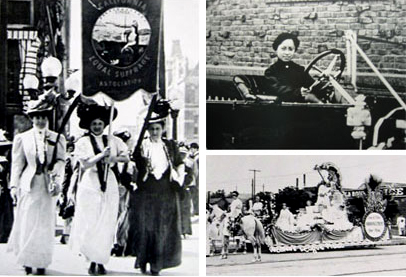
"Freedom has come, not as a gift, but as a triumph"
Alice Paul, Suffragist, 1919
"Citizenship is a question of not only rights and duties but also of identity"
Jane Rendall, Historian 1994
Produced by the International Museum of Women and The California History Center Foundation, this ten panel exhibition chronicles women's suffrage. The "California Woman Suffrage" exhibition embodies the Museum's mission of "raising the voices and status of women worldwide."
Suffrage is a core issue that links people together internationally. Almost everyone desires the freedom to participate in the society they live in and affect their environment. The International Museum of Women believes that women's suffrage is an important issue to cover because it depicts women of strength and conviction, and demonstrates that positive change can be achieved when women unite for a common cause.
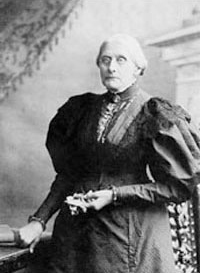
California Woman Suffrage Movement
The "California Woman Suffrage" exhibition was created to celebrate the success of women gaining full voting rights in California. Today many of us take voting for granted though women's right to vote in the United States came out of a long and often bitter battle. According to nineteenth and twentieth century suffragists, the vote was a chance for a voice in public affairs. It was in fact a legitimization of the right to participate in society. What the women asked for was equality under the law; property rights, guardianship of their children, and access to education. The first state-wide vote for women's suffrage in California came in 1896 when the women of the state asked Susan B. Anthony to organize their campaign. Yet, despite their efforts, the amendment failed. However, by 1911 California suffragists finally succeeded in getting the Progressive Republicans to place suffrage on the October ballot. In the end the fight for the enfranchisement of women was about the sharing of ideas and of trying many approaches, but most of all it was about the banding together for a common cause. It is this cause that the "California Woman Suffrage" exhibition captures and celebrates.*
View a chronology of worldwide woman suffrage (PDF).
* Excerpts from "California Woman Suffrage" speech by Jill Jensen
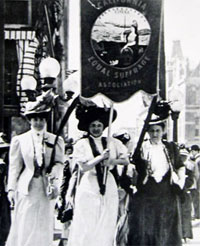
In Oakland, in 1908 three hundred women marched behind this handmade yellow silk banner bearing the California State Seal
The Campaign: 1870-1911
"Votes for Women these are three small words which constitute the biggest question of the political world today."
The Sacramento Congressional Record of January 1911
"The central figure in the seal of California is the presiding goddess of that state... But the constitution limits the franchise and thus makes outlaws of all the noble women who endured the hardships... who helped make (California) all that it is... The position of the real woman who shares the everyday trials and hardships... inspires no corresponding admiration and respect."
Elizabeth Cady Stanton, 1876

National leaders attend women's rights meetings at Mayfield Farm, the ornate home of and 250-acre property of pioneer Sarah Armstrong Montgomery Green Wallis. She was the first President of the California Woman Suffrage Association in 1870.
Organizing for Change... Out of the Parlor
In the early days and throughout the campaign, women developed plans at home, over tea or sewing. As their expertise grew, national leaders traveled within their own and nearby states to speak, lobby and organize. For all that, it was the neighbors, talking together, who were the core and strength of the movement.

Stanford University Students, - Stanford University Archives
What Women Wanted
"Men having felt the pressure of bad laws pertaining to themselves, have changed them, while women, with no political power, too hampered to organize still wear many of the shackles which the law originally fastened upon them."
From the pamphlet by Sarah M. Severence
All U.S. colleges categorically refused to admit women until Oberlin College in Ohio finally opened its doors for a special program in 1833. California state colleges admitted women in 1870, but schools of medicine and law kept them out longer. Stanford University opened as a co-educational institution, but later limited the number of women students.
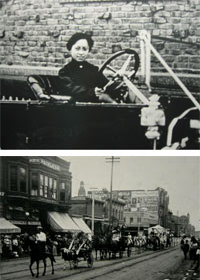
Ty Leung, Chinese historical society / Parade - 5th and E, San Diego Historical Society, Ti cor Collection
Organizing for Change... Into the Streets
Ty Leung was known for her social work among the Chinese in San Francisco. In 1912 she was the first Chinese-American woman to vote. Studebaker-Flanders took advantage of her prominence to put her in one of their cars for a publicity shot that ran in many San Francisco newspapers.
The centennial celebrations on July 4th, 1876 were a particular affront to women. They were being excluded from many parades and celebrations because they were using the occasion to express dissatisfaction with the Declaration of Independence.
- History of Woman Suffrage, ed. Elizabeth Cady Stanton
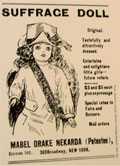
Women's Journal - Women's Heritage Museum, Palo Alto
Getting the Word Out
"Every legitimate method of campaigning was used, beginning with the printing of 900,000 leaflets...posters and all kinds of designs; city circularizing of the most thorough kind in many languages; pageants, plays, concerts and public social functions; the placarding of city billboards over miles of county...huge electric and other signs; long weeks of automobile campaigning in the country and the villages; special speakers; a handsome float in the labor day parade; speaking at vaudeville shows."
Mrs. David C. McCan, former president of the Southern California Women's Press Club, West Coast Magazine, July 1912
From a suffrage song entitled "Western Woman Voter," Written for the 1911 campaign:
Stanza 7.
Reuben, Reuben, home's no longer
Bounded by our flat's four walls;
Factory, prison, pure food, playgrounds -
Women hear a hundred calls.
Stanza 8.
Rachel, Rachel you've convinced me,
And I'll take you as my mate.
Women's proper sphere's the home dear -
But the home's our whole great state.

The Movement Against Suffrage
One argument of the anti-suffrage societies, composed mostly of women, was that politics was sordid and degrading. Further, they declared that women's influence in their own households was sufficient to their needs.
"Housewives: You do not need the vote to wash out your sink spout. A handful of potash and some boiling water is quicker and cheaper."
From a pamphlet published by the Woman's Anti-Suffrage Association of Massachusetts
"Your wife is elected to Legislature and your daughter is elected constable and you are at home taking care of the babies."
James Caples, Sacramento delegate, Second Constitutional Convention, 1879

Cannery, Henry E Huntington Library and Art Gallery / Labor Day Parade, Women's Label League No. 197 - The San Diego Historical Society Ti core Collection
Women's Work
" ...each day [women] must go out into the world to battle for their bread and butter...Many a one...leaves behind her children, parents or others, whom she must support...today, in America alone, we find seven million women self- supporting... working for longer hours and for lower wages than men."
Maude Younger, Labor Clarion, September 1911
"A large photograph of Miss Anthony and Miss Shaw was given for every $2 pledge, and many poor seamstresses and washerwomen fulfilled their pledges in twenty-five cent installments...And there were teachers and stenographers and other working women who went without a winter coat to give money to this movement for freedom."
Life and Work of Susan B. Anthony, Ida Husted Harper, 1898

Middle: Polling Place - California State Library Photograph Collection, M.H. Dobbin, "Album of San Francisco". Right: Capitol Steps, Lobbying for the Vote, Smithsonian Institution, Division of Political History
After 1911
Sara Bard Field Wood traveled with a driver and a mechanic in 1915 over cow paths and without road maps. She carried a huge petition with half a million signatures up the steps of the national Capitol to the waiting congressmen.
Other states passed woman suffrage after 1911, but the national government did not. The campaign to get national suffrage, led by Alice Paul, turned militant. Women were put in jail, went on hunger strikes, and were force fed.

